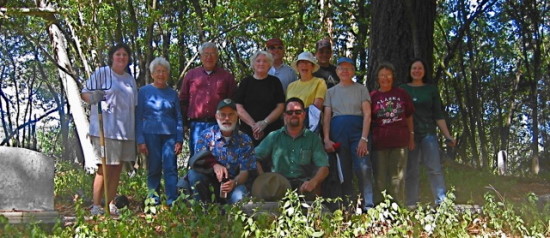
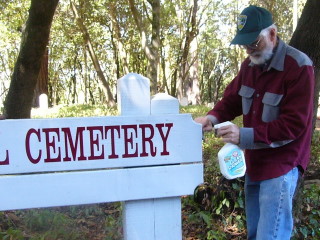
Cleaning sign
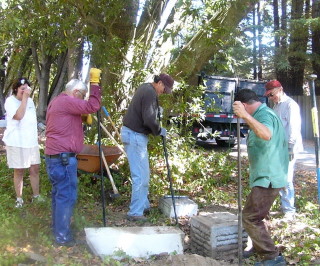
Resetting Crayne base
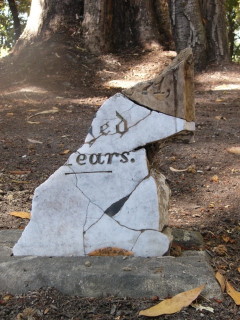
James Parmeter new pieces of stone
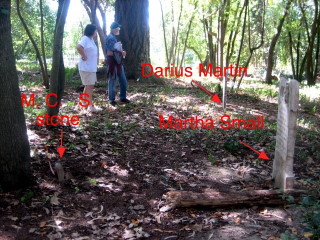
Small family stones
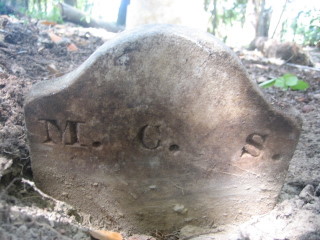
Mary Catherine Small stone
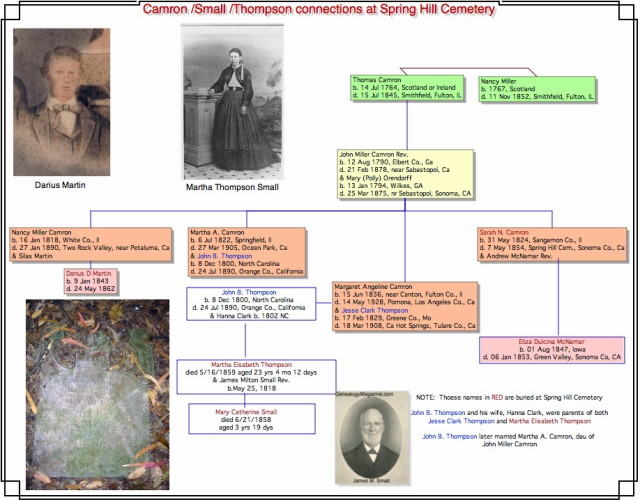
|
|
|
Dear Friends of Spring Hill Cemetery, Fog greeted us Friday morning as we began another rewarding day at the cemetery. Regional Parks had come by in the interval between our last two workdays and removed hazards we reported in July: they cut down the dead, small SOD tree in the north east section of the cemetery, sprayed for yellow jackets, and took down the "widow maker." We began our work session by cutting up and hauling the SOD downed tree and "widow maker" to the dump truck; by the end of the morning the truck was filled with gathered debris. Additionally, we reset 6 more bases, polished up the Spring Hill sign, discovered another piece to one of our headstones, and found one more complete stone. Twelve of us gathered for the morning's labor, and 14 of us attended the afternoon meeting on Spring Hill Cemetery scheduled by Regional Parks. All in all, I am delighted to report a very successful day. Many thanks to all of you who joined in. Much progress was made in the arduous job of resetting bases. We focused on those bases at the eastern edge of the cemetery, resetting those of Osmond Fairbanks, his brother Frank, Mary A Rogers, and the very large, difficult base for Daniel Crayne. Bases for Mary Ford and James Erb (in the northern part of the cemetery) were reset as well. Some of these bases are extremely heavy, and with the dry, hard, August ground, those tackling the task deserve extra praise. I think you can see from the attached picture just how strenuous a task resetting bases can be. I want to thank our very generous neighbors to the south, the McDowells, for the critically important use of their water for this work. To date 19 of our bases have been reset. I have been in contact with Gary Galeazzi, owner of North Bay Monument in Rohnert Park - the headstone expert and miracle worker who has pieced together and repaired Spring Hill's broken stones. He says he will come by the cemetery in the next week or two to review our progress, subsequently giving us instructions on where to go from here. He has also generously offered to continue his services in those areas of repair / resetting beyond our volunteer abilities. While raking around the Robertson graves, Patsy's rake encountered yet another chunk of James L Parmeter's headstone. As you can see from the attached photo, poor James' stone was shattered at some time in the past. The newly rediscovered piece fits just on top of the pieces we have assembled so far. It is particularly exciting to find a piece with a bit of his death date. James was the son of Jefferson D. Parmeter and Lavinia Robertson Parmeter, both of whom rest near him in the cemetery - his mother just south of him and his father just south of her. [correction: Jefferson D Parmeter was James L Parmeter's brother (not father). James L and Jefferson's father was John Spencer Parmeter] James died November 16, 1871 when just 8 years of age. Dick made our second discovery; Mary Catherine Small's stone. Mary Catherine was listed on the DAR Spring Hill burial list, but before Friday we had found no trace of her. There are 5 inter-related Camron / Small / Martin / McNamar / Thompson stones that should be at Spring Hill: Darius D Martin, Martha Thompson Small, Mary Catherine Small - plus two we have yet to find a trace of, Sarah Camron McNamar and her daughter Eliza. These are all among the earliest Spring Hill graves, dating from 1853 to 1862. The newly uncovered stone was where we expected to find it - just to the east of her mother, Martha Thompson Small. This group of connected graves has strong ties to the Cumberland Presbyterian Church and to the earliest origins of the cemetery. I will continue with Mary Catherine's stone, the Cumberland Presbyterian Church, and the Thompson / Small / Camron connections at the end of this email. But as it is rather long and may not be of interest to all, I will first recap the meeting we had with Regional Parks following our stint at the Cemetery. As mentioned earlier, 14 of the "Friends" met with Mary Burns, Jim McCray, John Ryan, Allan Darrimon, and Jerry King of Regional Parks; and with Susan Upchurch, staff assistant to Spring Hill's District 5 supervisor, Efren Carrillo. Last week I forwarded to all of you the documents Mary Burns had had drawn up - an agenda, volunteer cemetery worker job description, and a discussion document, "Friends of Spring Hill Cemetery Regional Parks' Plan for Volunteer Maintenance Activities." Regional Parks, as I have discussed in previous recaps, is under considerable budget stress, and are trying to formalize some of the issues around Spring Hill in part to better plan their limited resources. Introductions were made, and then Mary Burns asked that we try to cover areas of agreement first, putting contentious issues towards the end of the meeting. To that end, and with the exception of future burial policy, we reviewed most of the rest of the "Plan for Volunteer Maintenance Activities." Ms. Burns explained some of the terms - the Parks and Recreation Advisory Committee (PRAC) is an appointed body of 5, with each of the 5 county supervisors appointing one of the members. The "Director /designee" term refers to the Director of Regional Parks (Mary Burns) or her designee (likely to be Jim McCray). She went on to explain that they are requiring "prior written [Ms Burns said that email counts as written] approval" before such items as changes or improvements to paths because Parks must ensure they follow legal code (with paths they may need to consider the Americans with Disabilities Act). Allan Darrimon was the appointed scribe for the meeting, so will be coming out with comprehensive minutes. But outside of the burial issue, I feel confident that all the other issues will be quickly resolved. We then turned to the future burial issue. It is hard to distill the discussions into a few sentences, but as it is still an open issue, I will try to be brief. Mary Burns said after considering the issue, she was leaning towards recommending the cemetery be closed to all future burials. She and Susan Upchurch gave areas of concern. One concern seemed to be the time burials might require of Parks' staff. Patsy Marcussen who (with Candy Donnelly) had spent hundreds of hours drafting a burial plan for Spring Hill explained how we "Friends" feel much of their concerns are addressed in the draft burial policy. Additionally, Patsy and other descendants present, explained that although there are few burials at Spring Hill (about 1 a decade), it is very important to some of the descendants that they be allowed burial there, next to their pioneering ancestors. Spring Hill Cemetery is a living cemetery as well as an historic one, and descendants have a very special connection to it. As an example, Patsy read a letter from one of the Robertson descendants whose husband is buried in Spring Hill, and who has been planning to be buried alongside him since the day of their marriage - to the point of having it specified in her will. It was a beautifully written, heartfelt letter, which was much appreciated by all. Jeremy Nichols brought up that Sonoma County current has ongoing burials at one of the county owned cemeteries, and that perhaps whoever oversees those burials (coroner?) might be useful in Spring Hill's case. We ended that Mary Burns will look into the issue further. We have set a follow up meeting to further discuss burials following September 18th's workday. The meeting will be at 1:30 at the Sebastopol Veterans Hall on High Street (same venue as before). In researching the cemetery, I found that James McReynolds leased the land early on from John B. Thompson. It was on a portion of this leased land that James McReynolds buried his first wife in 1853. In 1862 James McReynolds began the purchase of the land from Thompson, and in 1865 the purchase was completed. In 1868 James McReynolds deeded the Spring Hill Cemetery portion of his land to the Cumberland Presbyterian Church in exchange for them maintaining the land as a cemetery in perpetuity. One of the Cumberland Presbyterian Elders mentioned in the deed was Jesse Thompson, son of John B. Thompson and brother to Spring Hill's Martha Thompson Small. The Spring Hill Website created and maintained by Larry Wendt has links to all of the early deeds tracing cemetery land. The website is at: http://www.wendtroot.com/cockrill/d0011/d0011notes/SpringHillCemetery.html. The John M. Camron family is a fascinating one, with ties both to Abraham Lincoln and the Cumberland Presbyterian Church. From the Bay of San Francisco The Metropolis of the Pacific Coast and its Suburban Cities. A History. Vol II Chicago, The Lewis Publishing Co, 1892: Near his mille he (John M. Camron) surveyed and laid out the village of New Salem and settled there, in 1827; and while residing there he was formally licensed to preach by the Cumberland Presbyterian Church, April 20, 1829; and there, too, Abraham Lincoln was for a time a member of his family, the future President being then, as he says in his autobiography, ' a sort of clerk in a store " in New Salem. At his store liquor was sold, of course, as was uniformly the custom in the country stores of that day; and when, in the famous campaign of 1858, Mr. Douglas accused Lincoln of having but a short time before " practiced behind the bar," Mr. Lincoln retorted, "Yes, I did, while my friend Douglas practiced before the bar ! .... In May, 1849, with his son and both families, he (John M. Camron) set out for California, arriving at Fremont, Sacramento county, November 6, whence they soon proceeded to Sacramento city and remained about three months. Father and son went to mining at Long Bar, Yuba county, and they gathered up several thousand dollars. In the autumn of 1850 they moved to Martinez, built a brick house and entered mercantile business, and also raised live stock on their farm in Danville, that county. In 1851 they moved to Petaluma, and in 1852 to Green valley, settling on a farm near Sebastopol... He {John M Camron} was a man of remarkable energy and zeal. He had ten daughters, as follows: Betsy, now Mrs. Baxter Berry; Nancy, the wife of S. M. Martin {their son, Darius is at Spring Hill}; Martha, the wife of Rev. B. N. Bonham {married secondly John B. Thompson, father of Martha Thompson Small}; Vina, first Mrs. Proise and by second marriage Mrs. Henry Lyster; Jane, Mrs. Charles Purvine; Serena, wife of Rev. Baxter B. Bonham; Selena [Sarah], wife of Rev. Andy McNamer {Sarah and daughter Eliza at Spring Hill}; Eliza Arminda, Mrs. Hiram Fogg, and by third marriage Mrs. Hugh Mundell; Caroline, the wife of Judge Thomas A. Brown; Margaret, Mrs. Jesse Thompson {Jesse Thompson being the son of John B. Thompson, brother of Martha Thompson Small}.
Caroline Winters, a "Friend of Spring Hill Cemetery" and a Martin descendant, gives a wonderful account of the Camron's journey to California in her book, Tapestry, self published in 2008. In it, Caroline writes, John [John M Camron] was fifty-eight when, in 1849, he organized a 40 wagon train. It included, in part, his son and family, the unmarried Camron daughters, and three married daughters with their husbands and families. May 1 they left Oskaloosa and began the trek to California. The following is an account found in Mother’s papers telling of the Camron trip in 1849. Spring of year 1849, John Camron led 40 wagons on trip from Iowa to California. Almost all the members of the Oskaloosa church went along. Camron had 4 covered wagons and a carriage for his family. Samuel Berry was the eldest being 69 years old. Charles Purvine, a son-in-law, drove 100 head of cattle. The first few days out of Iowa were very nice, but after crossing the Missouri they were in no-mans-land, among wild Indians, the plains hot and dry. Indians on Spanish ponies lurked on hidden trails. Camron, Baxter Bonham (a son-in-law) and Samuel Berry held prayers each evening. As they crossed the Alkali flats and hot desert there was much sickness. The carriage horses died from drinking poisoned water, they had to leave the carriage which Polly loved and they all enjoyed. The wagon train passed many graves where cholera was posted as warning. The 40-wagon-train arrived at Salt Lake settlement of the Mormons without a death and they were all thankful, but extreme heat by day and cool nights weakened their moral and members of the 36 wagons were fearful of going on till Spring. Camron saw the men eyeing his pretty daughters and decided to go on. Son Tom and family, 2 Son-in-laws and their families, Bonham & Purvine, John, Polly and other daughters not married. God being their guide they pulled out again. The ways ahead were heart breaking. They saw people at sides of trail that had been tomahawked, the wagons burned, wives and children missing, having been carried off by Indians. When they saw smoke or dust, John and train switched to another trail. Once when they knew Indians were watching they held such an impressive ceremony in prayer that it is said the Indians were afraid to attack. The group had sung loud and all took part. The Indian Chief is to have said “The birds of heaven have brought a message from our Great Father, these pilgrims are not to be touched. Wait until others who do not believe so come along. The Camron train never again had trouble. All along they read signs telling what trail to take and the hardships to come. They decided to take the Lassen trail. They lost 1 wagon, were all very cold as it got to 20 at night and they were short of food and depended on wild fruit and game, often not having enough to eat. A group of men heard of their coming and their situation and rode out several days to help and bring food.
James Milton Small was born in Virginia, then moved to Tennessee where he studied law. He gave up law for the ministry and in 1848 was ordained a Presbyterian Minister. From A History of the Man JAMES MILTON SMALL by W. G. Burris written in 1984, we are told, From Memphis he [James Milton Small] trekked to California during 1849 (a forty-niner!) arriving in Napa he turned to mining gold. By the fall of 1850 he abandoned mining and turned seriously to the ministry-- Napa's first preacher. A passage from "History of Northwest Texas". 1906, reads, "He started the organization of the first Masonic Lodge" (Yount No 12) "and rented a two story box house, the first floor of which was used for a church and school room and the upper floor for a lodge room." "The church which he organized became the First Cumberland Presbyterian Church of Napa City and with it and with the surrounding country in Sonoma County he was identified as a minister until 1872 when he removed to Texas." "Rev. Small became a Mason in 1845 and has taken all the Ancient Degrees, Blue Lodge, Chapter and Council. During active life he manifested much enthusiasm in the Ancient Craft and the Spirit of it's founder has animated him in the fulfillment of the Noble Purposes of the Order." It is known that he became disturbed at the developing wine industry: his belief in the evils of alcohol was strong and he turned his attention more and more to church related activities. On April 16, 1853 Nathan Coombs (our Master in 1919) sold to the First Cumberland Presbyterian Church of Napa City "for church uses purposes and no other", for one dollar, a lot lying 60' on Randolph and 120' on Spruce Street, Napa. "Signed, sealed and delivered by Nathan Coombs in the presence of C. Hartson and James M. Small (Minister)." By this time Rev. Bro. Small had commenced preaching on the circuit and became well known in Sonoma County. On March 29, 1854 he married Martha E. Thompson at Sonoma City; he lost Martha to Heaven and on January 6, 1861 James M. Small of Sonoma County married Francis J. Robertson of Nevada County. "Filed for Record by Reverend Small". After he moved to Texas during 1872 he continued to serve the church into 1898 when, at age 80, he retired to his home in Bowie, Texas. He died there on December 31, 1915, aged 97.
There is a discussion mentioning both James Milton Small and John M. Camron in History of the Cumberland Presbyterian Church by B W McDonnaold, DD, LLD 4th edition Nashville, Tenn: Board of Publication of Cumberland Presbyterian Church 1899: In the very beginning of our denominational work in this State the Rev. J. M. Small planted a church and built a house of worship in Napa City. In the neighborhood of one of Mr. Small's congregations, in 1852, some young unmarried men sustained a camp-meeting. The same year Mr. Small and others held a meeting in Sonoma, and secured money to build a house of worship. The Pacific Presbytery was organized in 1854, in the house of the Rev. J. M. Cameron. This presbytery established an academy at Sonoma, which in 1860 was turned over to the synod and called Cumberland College. It had a short but useful career. It was the first Cumberland Presbyterian school in California. There was wrangling over the location, and this, according to Mr. Dooley, was ultimately the cause of its death. Another, or at least an auxiliary cause can be found in the flitting away of all the first population of Sonoma. German wine growers now own the principal part of the beautiful country around the old college buildings. That rivalry and divided counsels injured not only Cumberland College at Sonoma, but other church work in California, is however a painful fact. The history of these differences and disputes would make a long chapter, but it would be useless to record it here. Martha Thompson married Rev. James Milton Small March 30th, 1854 in Sonoma County. Their daughter, Mary Catherine Small, was born the next year, but died in June of 1858 when just 3 years old. Martha was pregnant at the time of Mary Catherine's death - William Thompson Small was born on February 28, 1859. Martha died when her son was just 3 1/2 months old, May 16th, 1859. The Rev. James Small later married in Sonoma the widow, Francis J (Robertson) Hightower, and moved with son William Thompson Small to Texas.
Hope to see as many of you as can make it at the next workday, September 18th!
|
|
|
 |
|

Cleaning sign |

Resetting Crayne base |

James Parmeter new pieces of stone |

Small family stones |

Mary Catherine Small stone |
|
 |
|
![]()
This page created on 09/26/09 15:55.